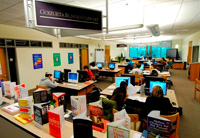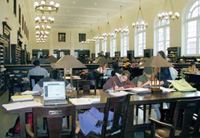Woodruff Library Looking Forward to More OIT Collaboration
March 16, 2012
 Recently, key leaders from the Woodruff Library and OIT participated in an all-day retreat in the pursuit of an improved partnership between the library and IT. Over the years the relationship between library science and information technology has grown, however it is as important as ever to further cultivate collaboration.
Recently, key leaders from the Woodruff Library and OIT participated in an all-day retreat in the pursuit of an improved partnership between the library and IT. Over the years the relationship between library science and information technology has grown, however it is as important as ever to further cultivate collaboration.
"The challenge," says Frances Maloy, Services Division Leader of the Woodruff Library, "is to bridge the gap in culture, language, and funding streams. OIT and the Library serve the same users, but our stakeholders and sponsors are very different."
OIT and the library both have a keen interest in wireless networks, storage, and security. Everyone on campus uses the network and having a strong wireless network is critical for today's information seeker. People have laptops and mobile devices and want the convenience of looking things up whenever and wherever they want. Constant access is very important and the wireless network is critical to library research. Good archival storage and security are key areas where OIT/Library collaboration is already quite active.
Kim Braxton, Alan Cattier, Wayne Morse, José Rodriguez and others from Academic Technology Services (ATS) attended the retreat and are the main source of interaction between OIT and the Library staff. Academic Technology Services (ATS), the Emory Center for Interactive Teaching (ECIT), and the Language Lab are housed in the Library, mainly because the Center for Library and Information Resources (CLAIR) was a joint project between the Library and UTS back in the 90's. CLAIR was a new kind of library where IT and library resources could come together.
 As an example of strong collaboration, Kim consulted on the formation of a "learning commons," where students would have one spot and one device to do research, study, write a paper, email a professor, surf the web...soup to nuts research. Kim's computing center was the model for running a great computer lab. She and Alex Kyrychenko (Learning Commons Coordinator) worked together to maintain software upgrades, imaging, and the back-end infrastructure, and now he manages the Learning Commons throughout the library and keeps the infrastructure similar to Cox Hall.
As an example of strong collaboration, Kim consulted on the formation of a "learning commons," where students would have one spot and one device to do research, study, write a paper, email a professor, surf the web...soup to nuts research. Kim's computing center was the model for running a great computer lab. She and Alex Kyrychenko (Learning Commons Coordinator) worked together to maintain software upgrades, imaging, and the back-end infrastructure, and now he manages the Learning Commons throughout the library and keeps the infrastructure similar to Cox Hall.
The ECIT team also collaborates with the library. Last year, ECIT employed a Clear Fellow (Brian Croxall) who did joint programming between ECIT and the library so that as people begin learning how to use a new research tool, they will also think about what library content they can implement as well. "But even though we are in the same building," says Maloy, "we still need to talk more."
Reserves Direct, which is an electronic way of managing and serving course content, is currently linked with LearnLink (LL) and Blackboard (Bb). Although Reserves Direct is an older software package, it still provides back-end processing that LL and Bb do not. When the Library goes to a new system, strong communication between the LL and Bb teams will be a must.
Library staff also recently met with Alan to discuss GoingOn and Office 365 and they are very excited about doing some testing. "The idea of a virtual service point is great because while the Library has multiple ways for students to reach us for help, the information is on the library website only," says Erin Mooney, the Outreach and Education Librarian. "A virtual service point would ideally provide access from any location within the network. If a question occurs, they can ask a librarian. It would increase our service business."
 Marc Overcash (Deputy CIO, R-WIT) also sees a lot of potential for Library collaboration with Research and Woodruff Health Sciences IT (R-WIT). He has asked to create links to databases in the Library to imbed library resources in various research tools.
Marc Overcash (Deputy CIO, R-WIT) also sees a lot of potential for Library collaboration with Research and Woodruff Health Sciences IT (R-WIT). He has asked to create links to databases in the Library to imbed library resources in various research tools.
Still, there is much more work to be done. "The Library has always had technology and automation, but has never fully integrated with academic and administrative computing," says Maloy. "Eventually, we've seen that operating two distinct groups is too expensive and we need to work together."
A strong library partnership will help in many ways, such as testing and coordinating with faculty to do testing as well. This kind of critical collaboration has been lacking in the past and as the relationship between the two groups continues to grow, new ways are likely to be found. According to Mooney, "I've always enjoyed working with OIT and I am excited about the projects that are coming."
